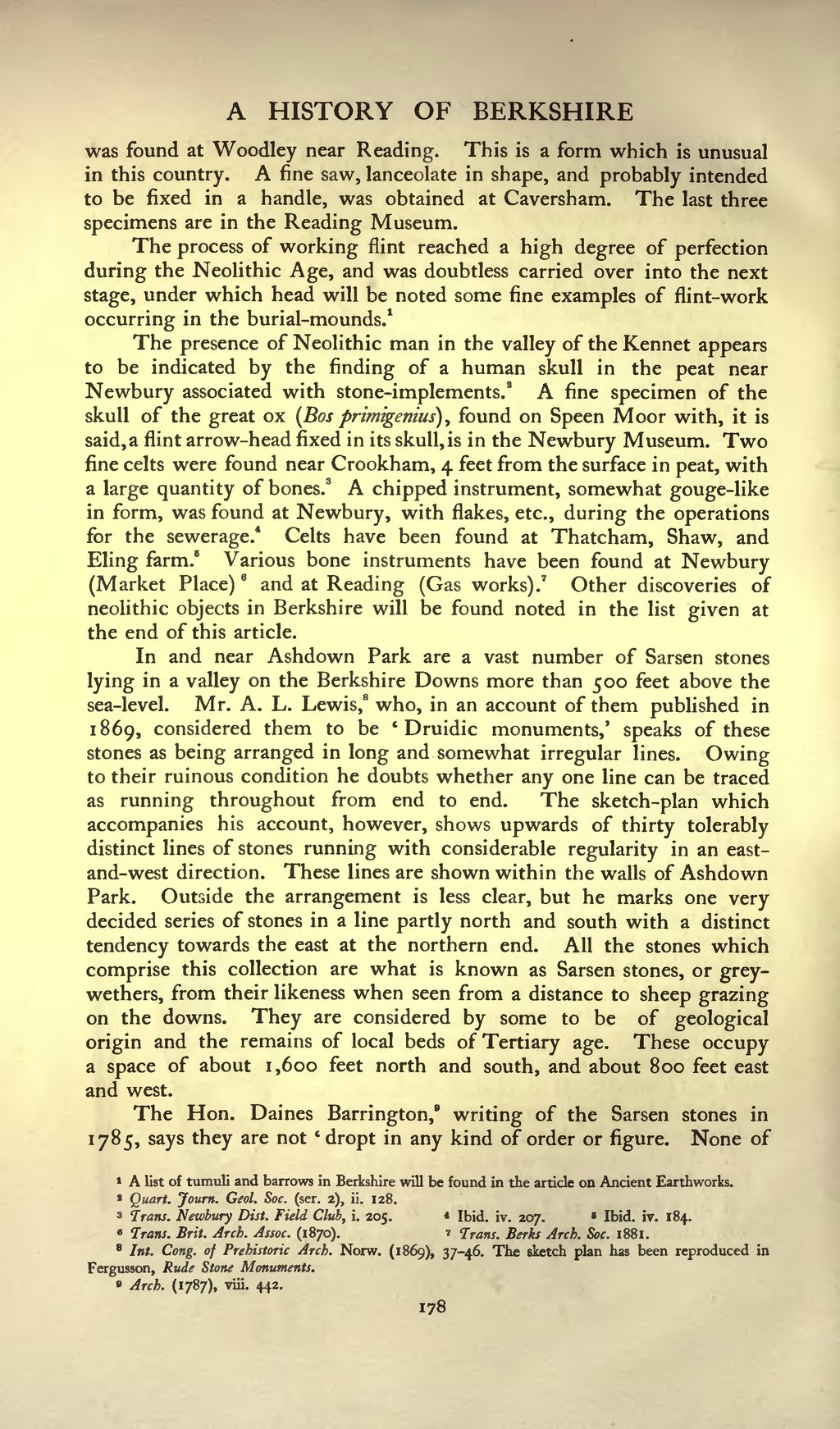A HISTORY OF BERKSHIRE
A HISTORY OF BERKSHIRE was found at Woodley near Reading. This is a form which is unusual in this country. A fine saw, lanceolate in shape, and probably intended to be fixed in a handle, was obtained at Caversham. The last three specimens are in the Reading Museum. The process of working flint reached a high degree of perfection during the Neolithic Age, and was doubtless carried over into the next stage, under which head will be noted some fine examples of flint-work occurring in the burial-mounds. 1 The presence of Neolithic man in the valley of the Kennet appears to be indicated by the finding of a human skull in the peat near Newbury associated with stone-implements. 3 A fine specimen of the skull of the great ox (Bos primigenius) , found on Speen Moor with, it is said, a flint arrow-head fixed in its skull, is in the Newbury Museum. Two fine celts were found near Crookham, 4 feet from the surface in peat, with a large quantity of bones. 3 A chipped instrument, somewhat gouge-like in form, was found at Newbury, with flakes, etc., during the operations for the sewerage. 4 Celts have been found at Thatcham, Shaw, and Eling farm. 5 Various bone instruments have been found at Newbury (Market Place) 6 and at Reading (Gas works). 7 Other discoveries of neolithic objects in Berkshire will be found noted in the list given at the end of this article. In and near Ashdown Park are a vast number of Sarsen stones lying in a valley on the Berkshire Downs more than 500 feet above the sea-level. Mr. A. L. Lewis, 8 who, in an account of them published in 1869, considered them to be ' Druidic monuments,' speaks of these stones as being arranged in long and somewhat irregular lines. Owing to their ruinous condition he doubts whether any one line can be traced as running throughout from end to end. The sketch-plan which accompanies his account, however, shows upwards of thirty tolerably distinct lines of stones running with considerable regularity in an east- and-west direction. These lines are shown within the walls of Ashdown Park. Outside the arrangement is less clear, but he marks one very decided series of stones in a line partly north and south with a distinct tendency towards the east at the northern end. All the stones which comprise this collection are what is known as Sarsen stones, or grey- wethers, from their likeness when seen from a distance to sheep grazing on the downs. They are considered by some to be of geological origin and the remains of local beds of Tertiary age. These occupy a space of about 1,600 feet north and south, and about 800 feet east and west. The Hon. Daines Barrington," writing of the Sarsen stones in 1785, says they are not ' dropt in any kind of order or figure. None of 1 A list of tumuli and barrows in Berkshire will be found in the article on Ancient Earthworks. 2 Quart. Journ. Geol. Soc. (ser. 2), ii. 128. 3 Trans. Newbury Dist. Field Club, i. 205. * Ibid. iv. 207. " Ibid. iv. 184. 6 Trans. Brit. Arch. Assoc. (1870). t Trans. Berks Arch. Soc. 1881. 8 Int. Cong, of Prehistoric Arch. Norw. (1869), 37-46. The sketch plan has been reproduced in Fergusson, Rude Stone Monuments. Arch. (1787), viii. 442. 178

